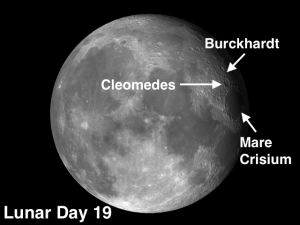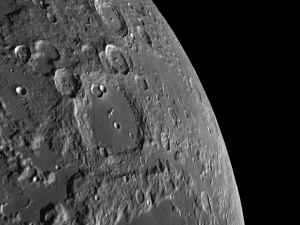 The week of March 13 – 19 takes us from Lunar Day 16, right after full moon, through Day 21. This week we will highlight the moon craters Cleomedes and Burckhardt, viewable on Thursday evening, in addition to Jupiter and Europa.
The week of March 13 – 19 takes us from Lunar Day 16, right after full moon, through Day 21. This week we will highlight the moon craters Cleomedes and Burckhardt, viewable on Thursday evening, in addition to Jupiter and Europa.
 Cleomedes: [NE/G15] Cleomedes is the first significant crater just north of Mare Crisium. It is a splendid crater, 80 miles in diameter, with terraced walls, rilles, and a small central mountain. There are also four craterlets and a Y-shaped rille on the northern half of the floor just east of the central mountain peak. Notice that the floor is unusually smooth. Because its southern rim touches one of the multi-rings encircling the Crisium basin, it is believed that lava rose up through Crisium fractures and smoothly covered the floor of Cleomedes. Under a low-angle Sun you might be able to detect that one of the rilles cuts through a small dome on the northern section of the floor. Immediately north of Cleomedes is the crater Burckhardt …
Cleomedes: [NE/G15] Cleomedes is the first significant crater just north of Mare Crisium. It is a splendid crater, 80 miles in diameter, with terraced walls, rilles, and a small central mountain. There are also four craterlets and a Y-shaped rille on the northern half of the floor just east of the central mountain peak. Notice that the floor is unusually smooth. Because its southern rim touches one of the multi-rings encircling the Crisium basin, it is believed that lava rose up through Crisium fractures and smoothly covered the floor of Cleomedes. Under a low-angle Sun you might be able to detect that one of the rilles cuts through a small dome on the northern section of the floor. Immediately north of Cleomedes is the crater Burckhardt …
 Burckhardt: [NE/F15] This is the crater with the “Mickey Mouse ears.” It is a remarkable exception to the rule that when one crater intrudes upon another, the younger crater (the intruder) is smaller. Burckhardt has landed smack in between two smaller but older craters, giving it the Mickey Mouse effect—so we get a double whammy!
Burckhardt: [NE/F15] This is the crater with the “Mickey Mouse ears.” It is a remarkable exception to the rule that when one crater intrudes upon another, the younger crater (the intruder) is smaller. Burckhardt has landed smack in between two smaller but older craters, giving it the Mickey Mouse effect—so we get a double whammy!
OF ADDITIONAL INTEREST IN SPACE – Jupiter and Europa:
On Wednesday night at 10:53 EDT, just as Jupiter rises, the shadow of Jupiter’s moon Europa will be in transit across Jupiter’s face, and Europa itself will just be beginning its transit. The shadow will have completed its journey at 1:15 AM EDT, and Europa at 2:15.
======================
It is highly recommended that you get a copy of Sky and Telescope’s Field Map of the Moon, the very finest Moon map available for use at the telescope. It is available for $10.95 at www.skyandtelescope.com and on Amazon. All features mentioned in this blog will be keyed to the grid on the Field Map and will look like this: Plato: [NW/D9]
Credits:
Courtesy of Gray Photography of Corpus Christi, Texas
Lunar photos: NASA / USGS / BMDO / LROC / ASU / DLR / LOLA / Moon Globe. Used by permission
- Rupes Cauchy: A Best Known Fault on the Moon - July 22, 2024
- Moon Crater Schickard – Crater Floor has Stripes - July 15, 2024
- Moon Craters Langrenus and Vandelinus - July 8, 2024